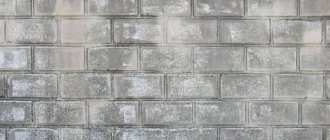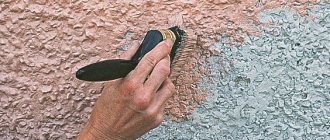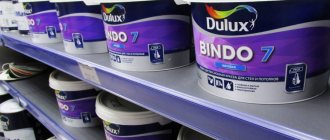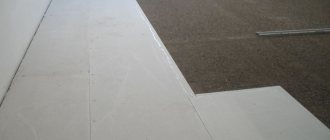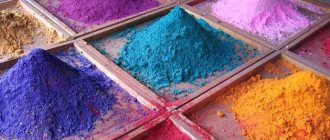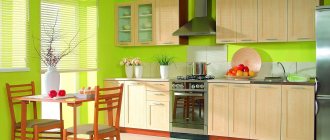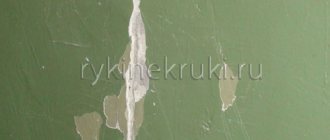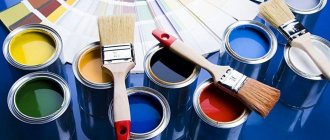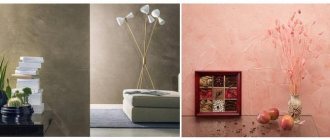Man is created in such a way that he gets bored with monotony. Often you want something new in life, in work and in the interior of your home. Often, in order to update their apartment or house, they resort to simple material that has been known for a very long time. What is it about? About regular paint. It is often used to treat walls. At the same time, the result is always surprising, since when done correctly, it all looks very beautiful. You just have to buy quality material. But here your eyes may run wild: there are so many types, so many colors, so many textures that it can be very difficult to choose.
How to figure it all out? We invite you to consider information about what types of wall paints exist and how to distinguish between them in order to choose the right option for yourself?
How to classify material
At first glance, you may think that buying wall paint will not be difficult. What's so complicated about that? But it is not so. There are many variations of paints, so some of them may not suit you. All materials differ in price, quality and characteristics. How can you separate colors? Let's consider:
These are the main criteria by which material can be distinguished. But that's not all. Wall paints may vary in composition. We will look at different compositions, their features and areas of application.
Differences in composition
In production, by adding certain components, the product is turned into something special. It has its own characteristics, advantages and disadvantages. What types of paints are there?
Water emulsion
Water-based or, as correctly, water-dispersion paint. The solvent in the material is water. That is why the mixture dries quite quickly and has no foreign odors. Water-based paint varies depending on the polymer that acts as a binder. It can be latex, acrylic resin or polyvinyl acetate. The last option is the cheapest; this paint is used to treat ceilings in dry rooms. The advantages of the paint are its vapor permeability, quick drying and lack of odor. In addition, it is easy to remove dirt from it.
Water-dispersed material can be divided into the following subtypes:
Oil formulations
As the name implies, they are made from oils, namely natural or synthetic drying oil. Various pigments are added to the composition, which dissolve in this oil.
The advantage of the material is that it is quite durable and strong. The composition can be used for internal and external work. However, it also has its drawbacks: it takes a long time to dry, it doesn’t allow air to pass through, and it doesn’t smell particularly pleasant. This is why such paint for walls in apartments is no longer used.
Alkyd material
The binder in the material is alkyd resin. It takes a little time for the composition to dry, since it dries due to the oxidation of the solvent upon contact with air. The surface is covered with a vapor-proof durable film. The smell from it is very pungent and unpleasant, so the use of the material in a residential area is quite rare.
Marker paint
Material based on epoxy resin, acrylic or polyurethane polymer. Once it dries, it creates a whiteboard effect. The composition is easily applied to a wall with a smooth surface, after which it hardens, creating a marker coating. The amazing thing is that you can write or draw on such walls with an erasable marker. After all the art, the marker is simply erased, leaving no marks on the wall. This is an ideal option for those who have small children. They love to paint on the walls, and with marker paint you don't have to do any renovations.
Note! The composition can be used to cover not only walls, but also furniture and interior items.
Facade paints: types and characteristics
There are many types of painting materials for facades. At the same time, their quality indicators, accordingly, will not be the same. You should consider what facade paints are available in order to subsequently navigate the choice of the most suitable material for processing the facade.
Vinyl paints
Vinyl (water-dispersion) paints have lost their relevance
Previously quite popular vinyl and polyvinyl acetate paints are not in great demand today due to the presence of acrylic materials on the paint and varnish market. A more familiar name for vinyl paints for many is façade water-dispersion paint.
When used in finishing work, this material must be diluted with water . The undoubted advantage of vinyl paint is its affordable price. As for quality indicators, they are very doubtful. Water-dispersed materials for covering facades quickly lose their performance properties when exposed to chemicals and mechanical damage. Vinyl paint shrinks greatly after drying. Mold can quickly form on a painted surface.
Acrylic-based facade paints
Acrylic-based facade paints meet the above criteria
Acrylic and acrylic-silicone paints, otherwise called latex, are based on acrylic organic resins. This type of facade paint is in high demand in modern construction, since its quality characteristics meet all reliability requirements.
The low water permeability of latex paints allows the painted surface to remain intact and uncontaminated for a long time. At the same time, the vapor permeability of the material is not too high, which somewhat reduces its service life .
The advantages of acrylic facade paints are:
Acrylic paints are tinted, so the color palette is quite extensive.
- large selection of colors and richness of shades;
- maintaining the brightness of the color of the painted surface for a long time;
- tightness and elasticity of applied layers;
- high abrasion resistance.
Acrylic-silicone paints are one of the subtypes of latex painting materials. They are characterized by a higher level of vapor permeability, but lower absorption. Acrylic-silicone solutions successfully combine the qualities of each type of paint, so their durability is significantly increased, and the painted surfaces exhibit the ability to self-clean.
We recommend that you study the article: the use of acrylic paint for exterior decoration.
Features of silicone facade paints
Thanks to the addition of silicone, the paint repels water
Silicone facade paints have several varieties: organosilicon, silane, siloxane. This type of painting material is considered hydrophobic, since moisture from precipitation is not absorbed into the surface of the wall, but simply flows down. Hydrophobicity allows you to significantly increase the strength and durability of the building façade; moreover, due to the property of repelling moisture, the surface becomes less contaminated.
The vapor permeability of silicone paints with a microporous structure allows moisture to quickly pass through the painted layers and evaporate from the outside. Another property that distinguishes facade silicone solutions is excellent adhesion.
Other types of facade paints
There are several other types of paints for facades, which are no less in demand among consumers.
Facade paint should be practical
Lime paints
Lime paints are best suited for plastering work
Modern manufacturers offer the consumer both ready-made solutions of lime paints and pastes, which must be diluted with a certain amount of water before use. Such paints do not contain organic resins, but there are substances that help disinfect the surface, thanks to which the painted facade is not subject to the formation of fungus and mold . Most often, lime paints are used for restoration work on facades covered with lime-based plaster (We recommend reading the article on facade paints for plaster in addition to this article). The most common shades are white and pastel.
Silicon (silicate) paints
Silicate paints for facades are an excellent option for finishing
Silicate paints have a fairly simple composition, however, their durability and abrasion resistance are high. The adhesive properties of silicon solutions are best demonstrated, but if there is a need to restore the facade, it is quite difficult to remove such paint . Silicate paint is practically immune to fungal and mold infections and the negative effects of precipitation.
Polysilicon (silicate-ash) paints
This improved modification of silicon (silicate) paints contains silicone resins. They are easy to apply to the surface, they have good vapor permeability and are very resistant to moisture. Polysilicon paint is recommended for painting facades covered with dry cement or cement-lime plaster .
Cement paint must be thinned
Cement paints
Such paints are sold on the market in the form of a dry mixture that must be diluted with water. The binder for cement paints is white Portland cement with polymer additives .
To add pastel shades to the initially white color of the material for painting the facade, you can add dyes. Cement paint has high vapor permeability and moisture capacity.
The concept of “decorative paint” for walls
Let's talk a little more about this species. Texture paint for walls appeared on the market not so long ago, but has already managed to gain its respect. Thanks to it you can achieve different design styles. Any texture can be imitated on the wall: silk, velvet, stone, silver, gold, etc. These techniques are used in designer rooms. Texture paint for walls is partly referred to as textured.
Note! There are products that change their color depending on the lighting in the room.
Decorative compositions can be classified as water-dispersive. Due to polymer or mineral substances, the composition changes and the desired effect is achieved. The material has many advantages: wear resistance, durability, safety for the body. In addition, the coating will not become covered with dust. This is an ideal option for decorating walls in an apartment.
Textured wall paint is applied in a special way, using special techniques and tools. These can be textured rollers, metal and plastic spatulas, as well as paint brushes of different sizes. There are many technologies for applying structural paint to walls. The result always surprises the owners.
The most popular manufacturers of facade paints
It is no secret that paints from different brands of the same type have their own qualitative characteristics. Therefore, it makes sense to familiarize yourself with the lines of facade paints from popular manufacturers on the market .
Some leading brands in the production of facade paints
- "Olympus" is a trademark representing structural facade paint based on acrylic with quartz filler. This material is suitable both for painting facades and for treating external and internal walls, ceilings, and basements. Anti-vandal paint "Olympus" is indispensable for covering surfaces in rooms with high traffic and load. Paint can be applied in several ways, resulting in different surface textures. Perfect for painting concrete, brick, plasterboard, chipboard, fiberboard, walls treated with putty or plaster.
- "Alpina" is a facade paint with high adhesion, good hiding power and excellent wear resistance. To give Alpina the desired shade, it is recommended to use colorants from the same manufacturer. Facade paint can be applied without problems and is characterized by a low level of water absorption and good diffusion.
- Silicone façade enamel KO-168 is often used to coat concrete, brick, wood and asbestos-cement surfaces for decorative and protective purposes.
- Facade paint XB-161 is characterized by fast drying (about 4 hours at an air temperature of +20 degrees). It is used for painting the facades of buildings of various types.
- Acrylic facade paint AK-124 contains white spirit and targeted additives, due to which it dries in a short time. Paints of the VD-AK series have excellent elasticity and durability (about 10 years), suitable for coating carefully prepared surfaces. The material is moisture-proof from the outside, vapor-permeable from the inside, and resistant to alkalis, smoke, and industrial gases.
- "Caparol" is a facade paint characterized by thermoplasticity and low water absorption. These properties provide excellent surface resistance to various types of contamination: dust and dirt are washed off at the first rain.
- “Optimist” is a water-dispersed acrylic-based facade paint that performs well both when painting facades and when covering internal surfaces in a building. The qualitative characteristics of “Optimist” allow the paint to be used in climatic conditions corresponding to most areas of Russia.
Magnetic wall paint
This type of material can be called no less new. We can say that these are innovative technologies, since thanks to paint with magnets, your photos, pictures or applications do not have to be nailed down, secured with buttons or tape. All this is already a thing of the past, since magnetic paint exists. After drying, the wall will turn into a magnetic board, because a magnet will be attracted to it.
The thing is that fashion dictates its own. Nowadays, decorative elements that hang on the wall are quite popular, especially photographs and pictures. Therefore, a material appears that can hold all this on the walls. And with magnetic paint, the task is simplified twice as much. The thing is that it contains iron particles. And as you know, a magnet attracts iron. The composition is applied to one or another area, which will be the place for decorative elements; this is a kind of refrigerator with magnets. The coating has gained popularity for use in cafes, offices, classrooms, kindergartens and schools, as well as at home. All you need to do is take a photo, drawing or picture and attach it with a magnet. It looks very nice.
Advantages of the material:
- No unpleasant odors.
- Ecological cleanliness. The use of magnetic paint is permitted in educational and medical institutions. No negative effects on people or animals.
- Fire safety.
- They have increased adhesion to any surface.
And what’s most surprising is that the composition has a unique property. It muffles electromagnetic radiation from the TV, computer and microwave oven.
Manufacturers
We saw that the range is really very large. But is it worth taking the first paint you come across? Not at all. It is worth paying attention to the manufacturer, since the quality depends on him. What kind of companies are these? For example, Finnish paint Tikkurila has long been known for its excellent products. It is ideal for walls.
And it’s also worth it, because the material shows good results on walls and ceilings. German companies are also good. But still, we are closer to the familiar “Sniezka”, from a domestic manufacturer. It is considered the best among Russian manufacturers. The price-quality ratio is excellent.
Coating vapor barrier from
offers a unique mastic "GizElast", which traditionally performs the functions of 100% waterproofing, as well as 100% vapor barrier, at affordable prices.
The composition is widely used in both industrial and private construction. In order to work with mastic, you do not need to have special professional skills. It is enough just to stir the one-component solution and cover the surface to be treated with it. The material is applied in one, or better yet, in two layers. Consumption is 1-2 kg per 1 m². The composition is suitable for application to flat surfaces - such as walls and ceilings, and for use in sealing seams and joints. This allows you to quickly and easily treat surfaces, making them completely vapor-tight. In order to achieve maximum effect from the work performed, when choosing materials, you should first of all pay attention to their quality. We offer only the highest quality products. GizElast mastic is always in stock. You can buy it and order delivery right here on the website, or by calling: +7 495 231-9661 Cost: The Technoprok company offers 2 alternative materials for vapor barrier of walls.
- emulsions and mastic compositions (made in Israel), known in Russia as liquid rubber.
- Eurovent roofing films (made in Germany), also known as roofing membranes.
Despite the fact that films are “under-roofing”, they are a traditional material for vapor barrier of walls
. Most builders know only this material and for many it is a revelation that vapor barrier of walls can be done with liquid or paste waterproofing materials.
Vapor barrier of walls with films
If someone prefers to do the vapor barrier of walls the old fashioned way or has the 2 limitations mentioned above, then the Technoprok company offers a wide selection of different diffusion films of the Eurovent brand.
Eurovent diffusion membranes with high vapor permeability are used as an under-roof covering for pitched insulated roofs, as well as for vapor barrier of walls
.
Eurovent vapor barrier films are products characterized by high mechanical strength, which is one of the key properties for high-quality vapor barrier.
High UV stability (4 months) does not limit the time it takes to complete the work before installing the roof. This is not so important for vapor barrier of walls from the inside, but is a significant factor when installing vapor barrier of walls from the outside or when installing roof vapor barrier.
The advantage of Eurovent brand products is, undoubtedly, their durability, confirmed by wear tests carried out in one of the leading laboratories in Germany, Institut für textile Bau und Umwelttechnik GmbH w Greven.
Testing products using simulated wear conditions is one of the requirements of the European standard EN13859-1. This standard applies to materials used as underlayment for pitched roofs.
The Technoprok company presents single-layer and multi-layer membranes and films of German origin, from which you can choose the optimal one for each task. Vapor barrier membranes are designed to protect not only the roof, but also the wall and floor from exposure to vapors, preventing the appearance of fungi, mold and rot in the wood.
Areas of application of vapor barrier LLC Technoprok
In addition to the vapor barrier of the walls
, liquid rubbers, both emulsions and mastics, are the most convenient and reliable materials when proper hydro- and vapor barrier of the floor is required. This is especially true for the first floor, located above the basement or in a wooden house or in a wet room (shower room, bathhouse, laundry room, swimming pool, etc.).
In order for the building to be dry and warm in any weather, it is necessary to carry out roofing work competently and efficiently, one of the conditions of which is the correctly carried out vapor barrier of the roof. The use of liquid rubber for flat roofing is also convenient because it allows you to quickly and efficiently install a vapor barrier layer over a large area.
In order for the vapor barrier of a house to be effective, protect the building from the penetration of moisture from the outside and protect the insulation from exposure to moist air, it is necessary to understand what steam, condensation and dew point are.
Technoprok company specialists will advise you on the use of vapor barriers and wind barriers. In addition, we have very affordable prices for the entire range. In our warehouse we always have liquid rubber and waterproofing mastics, geotextiles and drainage membranes - in short, everything that is necessary for installing a vapor barrier and.
Paint vapor barrier is, in fact, a special paint. But you shouldn’t expect any special attractiveness from her. The purpose of a vapor barrier is to prevent water from passing through, either in liquid or gaseous form.
For vapor barrier by painting, bitumen mastics are used, modified with various additives to bitumen: Kukersol varnish (a solution of shale tar in solvents), lingosulfanate, used as a plasticizer. The main purpose of these additives is to increase plasticity in the cold, but there are others: reducing flammability, increasing resistance to acids and alkalis, UV irradiation, etc. Chlorinated rubber is also used for the preparation of varnish, and polyvinyl chloride, for the same purposes, tar and gummastic mastics or emulsions.
Advantages and features of application
Vapor-permeable paint for interior work has an environmentally friendly composition and is completely safe for human health if the application technology is followed. The main advantages of the finishing material include:
- versatility in use - suitable for brick, concrete, wood, plastered surfaces;
- easy application due to high elasticity;
- quick drying;
- no condensation due to temperature changes;
- resistance to mechanical damage, moisture, mold and mildew;
- long-term preservation of rich color.
To get a good result, vapor-permeable interior paint is applied to the prepared surface. The base must be level and clean. Previously painted walls must first be cleaned and sanded until smooth. A primer is applied before painting. It improves adhesion and ensures uniform distribution of the coloring composition.
Vapor-permeable interior paint is usually applied in two layers. After drying, a durable, wear-resistant coating is formed that does not require special care and retains its impeccable appearance for a long time.
Properties of paint vapor barrier
All the materials that were just mentioned above are united by excellent hydrophobicity, primarily adhesion to water. They collect water in droplets on their surface, which roll off very easily. Moreover, not having any pores, they do not allow gases to pass through, including water vapor, which is also a gas.
According to the method of preparation, hot and cold mastics are distinguished. Hot ones are heated in boilers to a temperature of +120 ... +170°C, and cold ones are treated with solvents to reduce the viscosity to the required level. Gudrokam (gudrokam is a material obtained by oxidation of a mixture of bitumen and anthracene oil, has very high biological resistance) mastic should be heated only to 70 degrees, and for rubber-bitumen it is necessary to ensure a temperature of 200 and very good exhaust.
Vinyl chloride varnishes protect stone materials well from moisture penetration and form a very good vapor barrier in several layers (for example, XB-701 varnish). However, their temperature range is limited: -15 ... +40°C, so they are not suitable for external work in areas with cold climates.
What to look for when choosing facade paint
Without exception, all facade paints have characteristics that determine their quality. Let's consider which of them you should focus on when choosing a coloring solution:
- Binder . The quality of the future coating depends on it and its quantity in the solution. Synthetic acrylic, vinyl, silicone and silicate resins are often used as binders. In expensive and high-quality paints, the volume of binders is larger, while in cheap ones they are diluted with fillers, which increase the volume of the solution.
- Resistance to direct exposure to ultraviolet radiation . Thus, acrylic, acrylic-silicone and polysilicon paints are considered the most resistant to fading.
- Vapor permeability indicator . According to GOST, any finishing material for the facade must be permeable to steam, including paint. The indicator is determined by the mass amount of water that can penetrate 1 m2 of coating per day. The optimal façade vapor-permeable paint should have a vapor permeability value close to 130 g/m2 per day.
Scheme of a ventilated facade Kraspan
Advice!
When decorating the exterior of buildings with high humidity in interior spaces, for example, saunas, it is not recommended to paint the facade. It is better to use a more “breathable” cladding option, such as Kraspan ventilated facades.
- Water permeability . The best facade paints have low absorption capacity and therefore perfectly protect the wall from moisture penetration. The accumulation of moisture on the surface of the façade walls provokes the appearance of cracks and rapid contamination.
- Abrasion resistance . It means the number of dry or wet cleaning cycles that the coating can withstand before being completely abraded. The most appropriate value here is 5000 cycles.
- Paint consumption . As a rule, this indicator for different paints ranges from 100-300 grams per layer of surface area of 1 m2. However, this value largely depends on the surface of the substrate being painted. For example, if structural plaster facades are to be painted, the consumption may increase several times. When painting smooth surfaces, on the contrary, it will be lower.
Painting a porous and textured surface will always take more paint than finishing a smooth base
Advice!
The instructions on a can of high-quality paint always contain complete information about all the characteristics mentioned above. Therefore, when purchasing, you should not only consult with the seller, but also take the trouble to read about the technical properties of the selected solution. It would also be a good idea to first study the video with an overview of façade paints.
